


5-29-9, 12 PM, I got a good parking spot and am painting from my studio van. The steering wheel is my easle. Jacaranda Tree, Kula, 2009, #953 12:30 start charcoal drawing, 2:04 using a liner brush over the drawing, 2:43pm start painting, 5:00pm, 50% covered - no doubt most of the paint will be over-painted. I'll try to save any original impression colors and strokes that I can. It was sunny today and rainy yesterday. I'm not sure yet which direction I'll be going in.
|
| Day 1, 5-29-9. I used charcoal for the drawing, than went over the charcoal lines with a light blue wash.
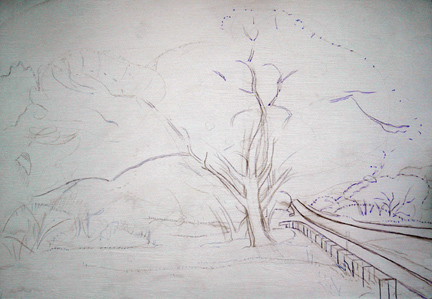 | Day 1, 40-50% covered with color.
It was cloudy and rainy all day.
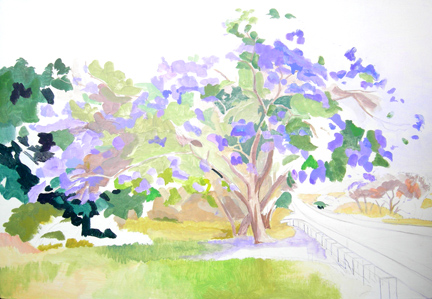 |
| TIP: Always add at least a little white to each color to leave room for the darks.
That's actually a tip from Rembrandt that I use. NOTE: I like to use the transparent colors when it's an advantage. Now, if the cobalt blue hue was made of PB:15.3 cyan and PR1:22 magenta it would be a handy half mix transparent cobalt blue color. Opaque cobalt blue is a fine color working it as the half-way between ult blue and cyan colors. This blue sky is cobalt blue and white. Ultramarine blue is translucent so it works well with transparent pigment in mixes. |
| Day 2, it was sunny today, I used mostly yesterday's colors and corrected the drawing. I'm not sure if I want the sun breaking through in the foreground or just some in the background, or an all overcast day with maybe some fog.
Tomorrow I should decide if it's the same as today. 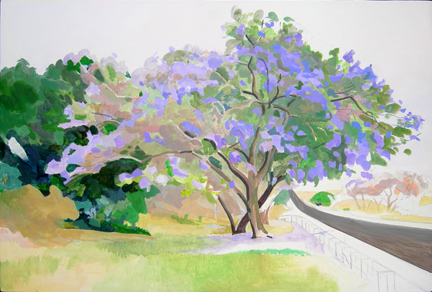 | Day 3, Today was a sunny day with clouds. This will be is my painting, for an instant I saw the tree half sun and half shadow as the cloud passed overhead. It's a late morning painting, the sun is less then half way up on my left, 11:00 AM. The sunlit side is light warm purple, the shade side is from cobalt to cool purple.
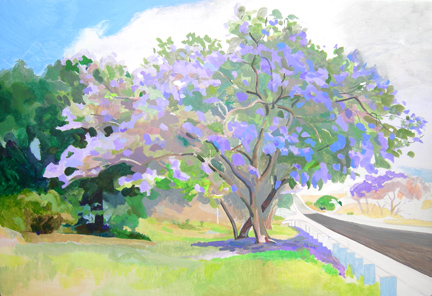 |
|
TIP: Don't use the same color from the middle ground in the back ground. Respect ariel perspective.
TIP: After you have color on your support use a white chalk to circle and mark places to make changes.
NOTE: Today I retired the worlds first Indian yellow acrylic. I bought it dry from the only company in the world that sold it dry, as there was no acrylic or water color Indian yellow in 7-23-01. Zecchi, a classical fresco supplier in Florence had the pigment. 1X 20 gr. Giallo indiano sost. - dry pigment, Nickle Complex pigment, B/s.
0998 20 gr. Giallo indiano (sobst) E 8.30. Indian yellow B/s. E8.30 That made a transparent triad of 3 Primary Dry Pigments; Indian yellow PY153, PY:150 from Zecchi, Magenta PR122 from Sennelier, Cyan PB15.3 from Senopia. These still are the cleanest, most permanent primary colors the world has ever known and I made the first acrylic because no one else would. We have come a long way in 8 years, many paint manufactures now have this color in the golden side, the brown side and the green side.
|
Day 4, I started the day with white chalk over the colors to mark changes in the picture. The main dark I am using in the foreground is PR:122 and PG:36, 1:1.
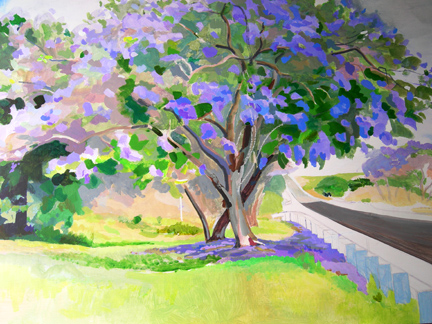 |
Day 4, This is the second chalk set, it's the way I paint.
I'm going to have sunlight and clouds jumping on the road.
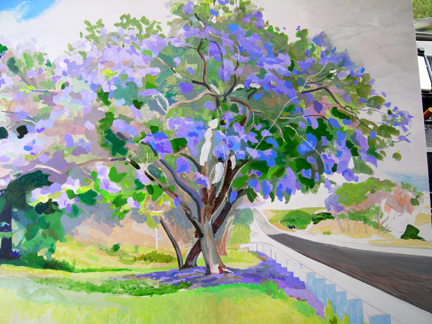 |
| TIP: Some of my brushes are over 30 years old, the secret? Never leave a brush in your water jar and clean the heel of the brush in isopropyl alcohol regularly.
TIP: Old Holland's acrylic Nickel Azo Brown - Lemon, is equal to dual-tone Indian yellow Br/s. A very good brown to yellow color, a must for every palette, PY:150 - PY:153. That little nob hill in the lower left area is a pure tint of O.H. Indian yellow brown/side. |
|
|
| Day 4 end, 5 hours. I have a good grip on the lighting for the picture, I think :)
It's not covered 100% yet so I'm not half way finished, there's is going to be a lot of detail in the road and background. 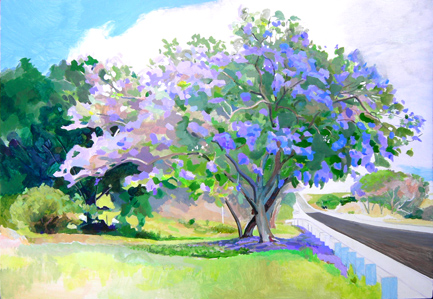 |
Day 5, 11:30 to 5:15. I got the sun lit branches first thing after marking up the painting with white chalk. The road and background now have a lot of local under color finished. About 10% is still white gesso and I want to show it Friday. That might be cutting it too close.
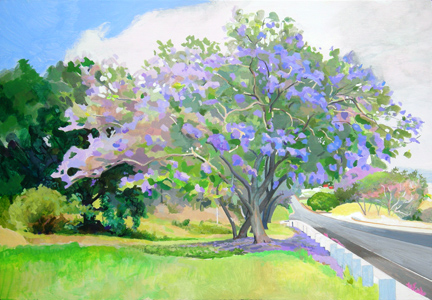 |
| TIP: To make darks in the sunlit afternoon use transparent green PG:36 and PR:122 magenta or purple PV:23 R/s. Cool dark shadow colors in the morning or the under sides of clouds use ultramarine blue and burnt umber.
TIP: Adding transparent cyan PB:15 to opaque cadmium yellow PY:35 makes a cooler mass green than adding yellow to green yellow side or green blue side. TIP: If your right handed paint from the top left to the bottom right so you won't smear new paint. TIP: Knowing your "erasure time" is important. One minute after laying the wet paint on dry paint is easy if your are painting in the shade on a hot day. In moist climents you have an hour and more. It rains a lot in some areas on Maui, the next day I can remove yesterday's last layer and the next layer, one at a time. Beats oil paint. TIP: Shadow color on the orange flower is the opposite color cobalt blue. The red house is toned down with it's opposite color cyan. |
|
|
12:00 to 4:15. The orange spots on the left are the flowers of a black oak tree, sometimes it's called a silver oak. It's nice to catch both trees blooming in one painting. Tomorrow I plan on making the sunlit and cloud areas more pronounced. It's 100% covered and I have two days to finish.
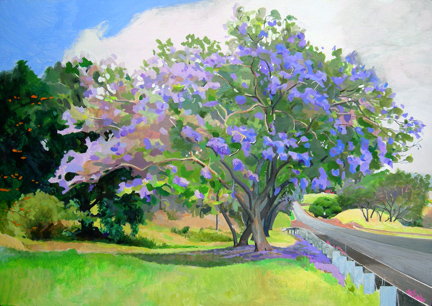 |
Day 7, 11:30 to 4:00. I'll never get it finished in time for the start of the show tomorrow.
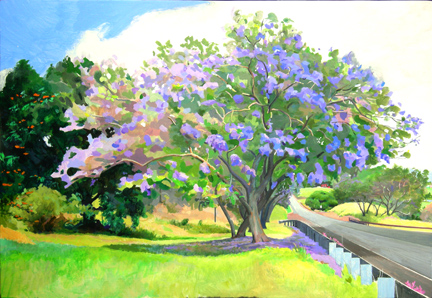 |
| TIP: Use a water based polyurethane final coating to protect your acrylics. I have been using that for 30 years and my work still looks as pristine as the day it was painted. Another plus for polyurethane is your work can be stacked and they won't stick together.
TIP: When you are using alcohol to clean your brushes, soak them in a nearly horizontal position, don't wet past the ferrule, use a brass cleaning brush. Clean right up to the ferrule until the brush looks like when you bought it, it could take 1/2 hour per brush. Some of my brushes are not available anymore, not in the style or size, they are irreplaceable. It's a tossup between crying and throwing something if I loose a brush hair. TIP: Wash off your painting every 3 days when painting outdoors without a maul stick, whether it needs or not... |
|
|
It's 95% finished, I just have to check the 11:00 colors and shadows again.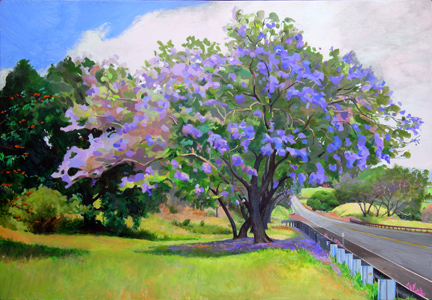 |
6-6-9 Finished.
Notice the original first day strokes saved in the final.  |
| TIP: Photograph your washed and unglazed art work in bright shade (no sun and a lot of sky) for a saturated image. |
Painted by Don Jusko, 6-6-9, #953 |
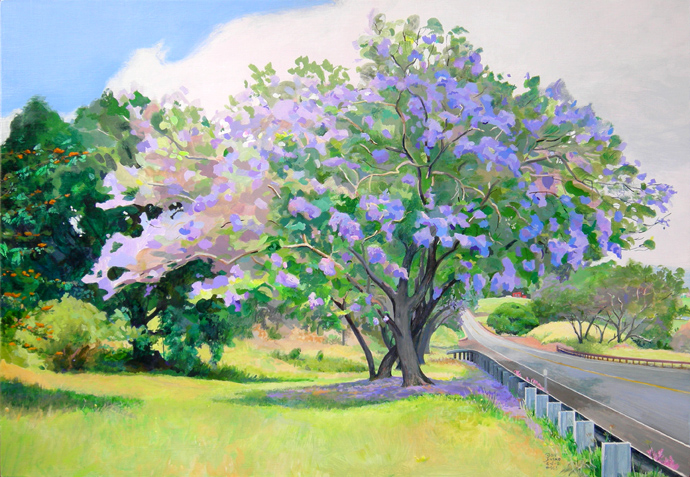 |
5-20-2 Early Spring Jacaranda Acrylic
6-5-2 Highest Jacaranda 4,000 Ft. Oil
6-15-2 Jacaranda and Driveway 3,500 Ft. Oil
3-21-3 Silver Oak and Jacarandas 2,000 Ft. Acrylic
#897 4-24-3 one Acrylic three Knife Oils
4-29-3 to 5-7-3 Oil
4-11-3 Acrylic 30x22
5-21-3 3,000 Ft. Acrylic
June, 2005, Kula, Copal Medium, Oil Medium, Water Color Medium
5-22-3 Knife Paintings Oil
5-27-03 /acrylic
4-26-5 mastic and wax
May 2005, 2 Oil, 1 Mastic and Wax, 2 watercolors
4-26-6 Mike's house, blue, Acrylic
4-29-7 to 5-9-7 Oil
5-10-7 to 5-20-7 Holy Ghost Church Acrylic
5-10-7 to 5-20-7 Kula Post Office Jacaranda Acrylic
Jacaranda Seabury Hall 2008, Maui, HI
Jacaranda at Makawao Library, Maui, HI
NEXT PAINTINGS, Villa Tamarinda Palm, acrylic, kaupodonlaurinpalm.htm
PREVIOUS,
Jacaranda Season 2006, acrylic, Mike's blue house, jacarandamike2006.htm
|
|